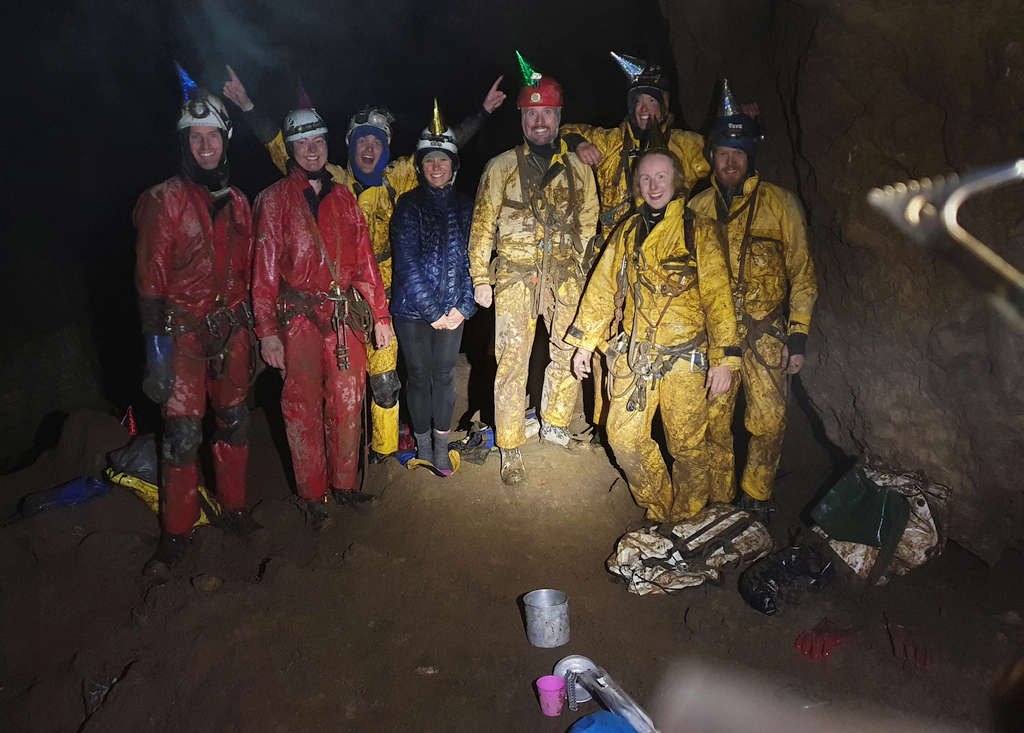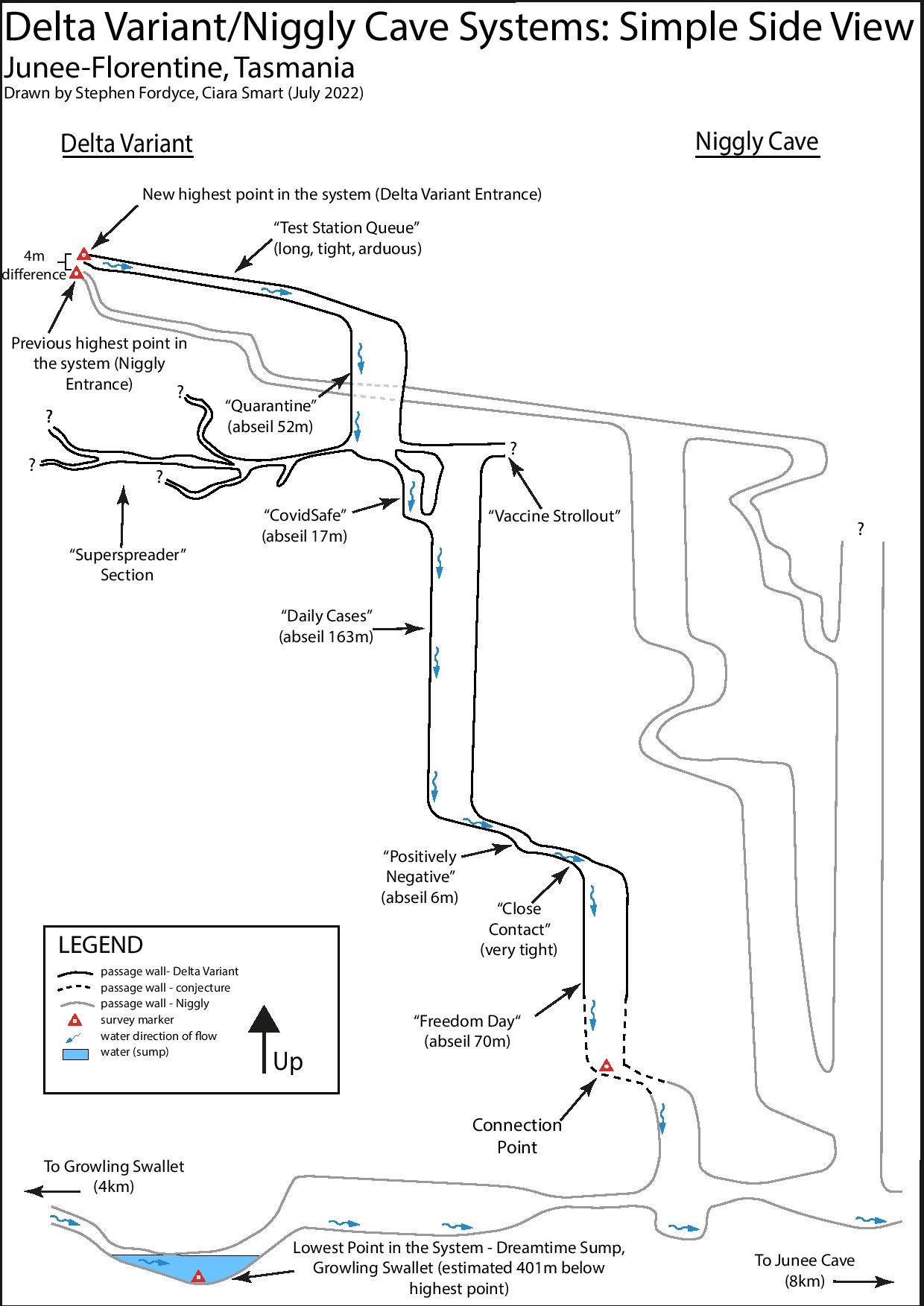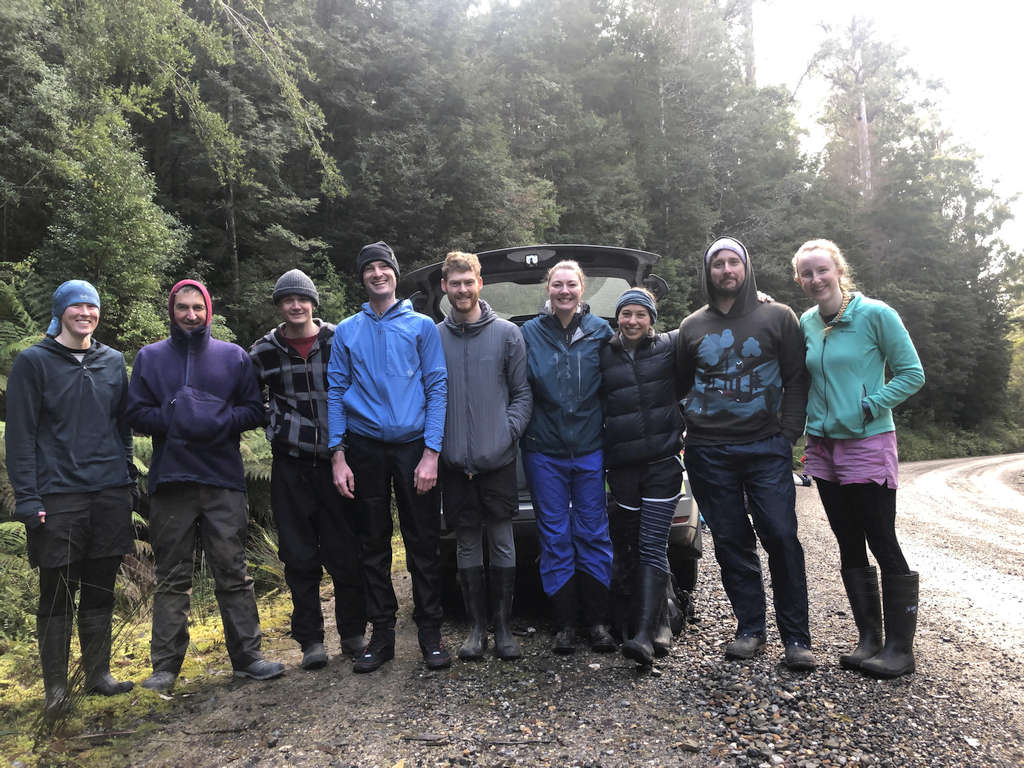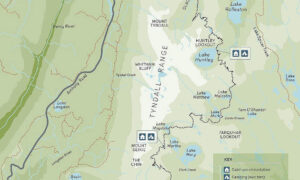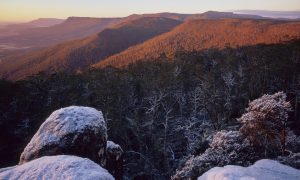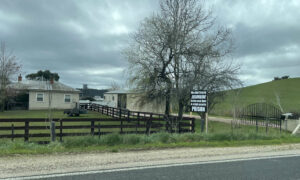Media release – Southern Tasmanian Caverneers, 31 July 2022
Australian Cavers set new Depth Record
Yesterday, an elite team of nine cavers from the Southern Tasmanian Caverneers set a new record for the deepest cave in Australia. The team successfully connected a newly discovered cave, named ‘Delta Variant,’ to the Niggly/Growling Swallet Cave system, taking the record for Australia’s deepest known cave to an anticipated 401 vertical metres.
To prepare for this attempt, the team spent the last six months fixing ropes down the cave and exploring side passages, as part of a decades-long project to unravel the mysteries of Australia’s deepest caves. Sensitive dye tracing techniques and laser surveying had been used to confirm the cave’s position and connection to a known point in Niggly Cave in anticipation of the connection.
The team entered Delta Variant around 11am Saturday morning. After first negotiating a difficult horizontal section, they descended down the ropes that had been fixed over the last six months. At 4pm they reached the end of the last rope left on the most recent trip. They tied in one more rope, descended another 35m, and reached the bottom of Delta Variant, breaking through into the Niggly System. The team then exited via the Niggly System to achieve the first system traverse using this entrance.
The team faced very challenging conditions underground with high water levels owing to recent snowfall on the surface. The team spent more than fourteen hours underground to complete the connection, emerging from the cave at 1:30am, and walking another hour back to their cars.
To put the cave’s scale in perspective, team member Ciara Smart, said,
“That 400m depth represents almost six Wrest Point Casinos stacked on top of each other, or three Sydney Harbour Bridges. Making the connection between Delta Variant and Niggly is a momentous achievement for the caving community, but also adds to our scientific understanding of the extensiveness of Australia’s karst systems.”
The discoverer of the cave and project organiser, Stephen Fordyce, named the cave ‘Delta Variant,’ to remind future cavers of contemporary events. Mr Fordyce described the cave as ‘highly technical’,
“It is a very challenging cave to negotiate. Saturday’s trip involved an hour and a half bushwalk up a hill, then over 14 hours of abseiling, crawling, squeezing, and rope-climbing, then a long walk back down the hill. About 300m vertical metres was descended on ropes, then painstakingly climbed back up again, with heavy packs full of wet, muddy ropes. The longest continuous abseil is 163 metres high. That’s the height of a 53-story building.”
Team member Jemma Herbert explained,
“This is a collaborative project building on the work of generations of cavers before us. Until six months ago, no one even knew that this cave existed. Despite decades of exploration in the area, Tasmania’s caves still hold many secrets.”
Team member Karina Anders added,
“The actual logistics of preparing for this connection have been intense. It takes a huge amount of planning to have the right people and equipment in the right place. It’s been like climbing a mountain in reverse. Each trip we have taken as much rope as we can carry, then descended down while exploring side passages, then we go back up. The next trip we bring more rope and go a bit further.”
A cave’s height is measured from the highest entrance to the lowest known point. The lowest point in the Niggly/Growling Swallet system is the Dreamtime Sump, a flooded section of passage successfully cave-dived by Stephen Fordyce in 2019. Ironically, generations of cavers had been very close to the entrance to Delta Variant, as it lies only a few metres away from the entrance to the Niggly System, the previous deepest cave, which was discovered in the 1990s. Of this, Brendan Moore, who was present at the moment of discovery, said,
“Amusingly, the entrance to Delta Variant is only about 4 metres up from the Niggly entrance. Cavers have been so close for decades! However, it is up a short, steep cliff, which no one had ever thought to climb. The actual entrance is hidden by thick scrub and fallen logs. It just shows you what the Tasmanian bush can hide.”
Caver Ben Armstrong described the challenging conditions,
“The cave was very strenuous. It was extremely vertical, requiring hundreds of metres to be ascended and descended on ropes. Water levels were high, and placing the final ropes required some very creative improvisation.”
Saturday’s team was composed of Karina Anders, Ben Armstrong, Stephen Fordyce, Lauren Hayes, Jemma Herbert, Brendan Moore, Ciara Smart, Petr Smejkal, Rolan Eberhard. Other project members include Gabriel Kinzler, Alan Jackson, Anna Jackson, Lachlan Bailey, and John Oxley. The project has been run by the Tasmanian Southern Caverneers, a caving club based in Hobart. The club welcomes new members interested in caving, and taking part in this ongoing citizen science project.

